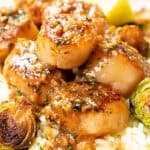Pan Seared Scallops with Brown Butter Sauce
Golden, buttery scallops with a crispy sear, drenched in a nutty brown butter sauce infused with garlic, lemon, and fresh parsley. Simple, elegant, and crazy delicious!
Servings 4
Calories 337
Ingredients
- 1 ½ lbs dry sea scallops 10 to 20 per pound, tendons removed
- ½ teaspoon salt
- ½ teaspoon black pepper
- 2 tablespoons vegetable oil
- 2 tablespoons unsalted butter
For the brown butter sauce:
- 4 tablespoons unsalted butter cut into pieces
- 6 cloves garlic minced
- 2 tablespoons fresh parsley minced
- 1 tablespoon lemon zest
- 2 teaspoons lemon juice
- Salt & pepper to taste
Instructions
- Prepare the scallops: Pat scallops dry with paper towels. Place them on a clean dish towel-lined plate or baking sheet. Cover with another towel, press gently, and let sit for 10 minutes to remove any remaining moisture.
- Make the brown butter sauce: In a small saucepan over medium heat, melt the butter. As it melts, it will begin to foam. Swirl the pan frequently for even browning. After 3 to 4 minutes, the butter will turn a deep golden brown and smell nutty. Remove from heat and stir in the garlic, parsley, lemon zest, and lemon juice. The ingredients will sizzle. Season with salt and pepper. Cover and set aside.
- Sear the scallops: Season scallops with salt and pepper. Heat 1 tablespoon oil in a large nonstick skillet over high heat until just smoking. Add half of the scallops in a single layer, flat side down. Cook without moving for 1½ minutes, until a golden-brown crust forms. Flip and cook for another 1½ minutes. Transfer to a plate and tent with foil. Repeat with remaining oil and scallops.
- Add the sauce: Once all the scallops are cooked and removed from the pan, reduce the heat to low. Pour the prepared brown butter sauce into the skillet and stir, scraping up any browned bits from the pan. Let the sauce warm for about 30 seconds, then return the scallops to the pan. Spoon the sauce over the scallops to coat them.
- Serve: Plate the scallops and drizzle with extra sauce. Serve immediately with lemon wedges. Enjoy!
Video
Notes
Erren's Top Tips
- Dry Scallops Are Key: The drier the scallops, the better the sear. Pat them down with paper towels and let them rest between clean dish towels for about 10 minutes to remove all moisture.
- Use High Heat: Don’t be afraid of high heat! You want that skillet screaming hot to create that crispy, golden crust. If the pan isn’t hot enough, the scallops will steam instead of sear.
- Don’t Overcrowd the Pan: Cook in batches if needed. Overcrowding the pan traps steam and makes it impossible to get a good sear.
- Resist the Urge to Move Them: Once the scallops hit the pan, don’t touch them for about 1½ minutes. You’ll know they’re ready to flip when they easily release from the pan.
- Brown Butter Perfection: The butter will foam before it browns—keep swirling to make sure it cooks evenly. Once it smells nutty and turns deep golden brown, take it off the heat.
- Don’t Overcook: Scallops cook FAST. Overcooking makes them rubbery, so pull them off as soon as they’re opaque and firm to the touch—about 1½ minutes per side.
- Serve Immediately: Scallops lose their texture quickly as they cool, so serve them right away for the best experience.
Storage & Freezing Instructions
Storing Leftovers:Place cooked scallops in an airtight container and refrigerate within 2 hours of cooking. They’ll keep for up to 2 days, but the texture will change slightly. Reheating:
Scallops tend to lose their texture quickly after cooking, so it's best to eat them on the same day. If you have leftovers, reheat the scallops gently in a nonstick skillet over low heat, adding a bit of butter to keep them moist. Avoid using the microwave, as it can make them turn rubbery. Freezing:
Honestly, scallops are best enjoyed fresh. Freezing cooked scallops isn’t recommended as it drastically changes the texture. If you must freeze them, store them in an airtight container and freeze for up to 1 month. Thaw slowly in the refrigerator and reheat gently.
Nutrition
Calories: 337 | Carbohydrates: 8g | Protein: 21g | Fat: 25g | Saturated Fat: 12g | Polyunsaturated Fat: 5g | Monounsaturated Fat: 6g | Trans Fat: 1g | Cholesterol: 86mg | Sodium: 962mg | Potassium: 391mg | Fiber: 0.4g | Sugar: 0.2g | Vitamin A: 701IU | Vitamin C: 7mg | Calcium: 30mg | Iron: 1mg
